Bengali Language Movement
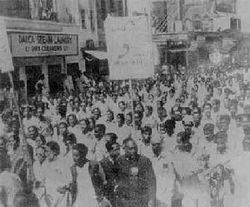
The Bengali Language Movement, also known as the Language Movement (Bengali: ভাষা আন্দোলন; Bhasha Andolon), was a political effort in Bangladesh (then known as East Pakistan), advocating the recognition of the Bengali language as an official language of Pakistan. Such recognition would allow Bengali to be used in government affairs.
When the state of Pakistan was formed in 1947, its two regions, East Pakistan (also called East Bengal) and West Pakistan, were split along cultural, geographical, and linguistic lines. In 1948, the Government of Pakistan ordained Urdu as the sole national language, sparking extensive protests among the Bengali-speaking majority of East Pakistan. Facing rising sectarian tensions and mass discontent with the new law, the government outlawed public meetings and rallies. The students of the University of Dhaka and other political activists defied the law and organised a protest on 21 February 1952. The movement reached its climax when police killed student demonstrators on that day. The deaths provoked widespread civil unrest led by the Awami Muslim League, later renamed the Awami League. After years of conflict, the central government relented and granted official status to the Bengali language in 1956. In 2000, UNESCO declared 21 February International Mother Language Day for the whole world to celebrate[1], in tribute to the Language Movement and the ethno-linguistic rights of people around the world.
The Language Movement catalysed the assertion of Bengali national identity in Pakistan, and became a forerunner to Bengali nationalist movements, including the 6-point movement and subsequently the Bangladesh Liberation War in 1971. In Bangladesh, 21 February is observed as Language Movement Day, a national holiday. The Shaheed Minar monument was constructed near Dhaka Medical College in memory of the movement and its victims.
Contents |
Background
The present nations of Pakistan and Bangladesh were part of undivided India during the British colonial rule. From the mid-19th century, the Urdu language had been promoted as the lingua franca of Indian Muslims by political and religious leaders such as Sir Khwaja Salimullah, Sir Syed Ahmed Khan, Nawab Viqar-ul-Mulk and Maulvi Abdul Haq.[2][3] Urdu is an Indo-Aryan language of the Indo-Iranian branch, belonging to the Indo-European family of languages. It developed under Persian, Arabic and Turkic influence on apabhramshas (last linguistic stage of the medieval Indian Aryan language Pali-Prakrit)[4] in South Asia during the Delhi Sultanate and Mughal Empire.[5] With its Perso-Arabic script, the language was considered a vital element of the Islamic culture for Indian Muslims; Hindi and the Devanagari script were seen as fundamentals of Hindu culture.[2]
While the use of Urdu grew common with Muslims in northern India, the Muslims of Bengal (a province in the eastern part of British India) primarily used the Bengali language. Bengali is an Eastern Indo-Aryan language that arose from the eastern Middle Indic languages around 1000 CE[6] and developed considerably during the Bengal Renaissance. As early as the late 19th century, social activists such as the Muslim feminist Roquia Sakhawat Hussain were choosing to write in Bengali to reach out to the people and develop it as a modern literary language. Supporters of Bengali opposed Urdu even before the partition of India, when delegates from Bengal rejected the idea of making Urdu the lingua franca of Muslim India in the 1937 Lucknow session of the Muslim League. The Muslim League was a British Indian political party that became the driving force behind the creation of Pakistan as a Muslim state separate from British India.[7]
Early stages of the movement
After the partition of India in 1947, Bengali-speaking people in East Pakistan (also known as East Bengal) made up 44 million of the newly formed Pakistan's 69 million people.[8] Pakistan's government, civil services, and military, however, were dominated by West Pakistanis.[9] In 1947, a key resolution at a national education summit in Karachi advocated Urdu as the sole state language, and its exclusive use in the media and in schools.[10][11] Opposition and protests immediately arose. Students from Dhaka rallied under the leadership of Abul Kashem, the secretary of Tamaddun Majlish, a Bengali Islamic cultural organisation. The meeting stipulated Bengali as an official language of Pakistan and as a medium of education in East Pakistan.[12] However, the Pakistan Public Service Commission removed Bengali from the list of approved subjects, as well as from currency notes and stamps. The central education minister Fazlur Rahman made extensive preparations to make Urdu the only state language of Pakistan.[13] Public outrage spread, and a large number of Bengali students met on the University of Dhaka campus on 8 December 1947 to formally demand that Bengali be made an official language. To promote their cause, Bengali students organised processions and rallies in Dhaka.[8]
Leading Bengali scholars argued why only Urdu should not be the state language. The linguist Muhammad Shahidullah pointed out that Urdu was not the native language of any part of Pakistan, and said, "If we have to choose a second state language, we should consider Urdu."[14] The writer Abul Mansur Ahmed said if Urdu became the state language, the educated society of East Pakistan would become 'illiterate' and 'ineligible' for government positions.[15] The first Rastrabhasa Sangram Parishad (National Language Action Committee), an organisation in favour of Bengali as a state language was formed towards the end of December 1947. Professor Nurul Huq Bhuiyan of the Tamaddun Majlish convened the committee.[8][16] Later, Parliament member Shamsul Huq convened a new committee to push for Bengali as a state language. Assembly member Dhirendranath Datta proposed legislation in the Constituent Assembly of Pakistan to allow members to speak in Bengali and authorise its use for official purposes.[8] Datta's proposal was supported by legislators Prem Hari Burman, Bhupendra Kumar Datta and Sris Chandra Chattaopadhyaya of East Bengal, as well as the people from the region.[8] Prime minister Liaquat Ali Khan and the Muslim League denounced the proposal as an attempt to divide the Pakistani people, thus the legislation was defeated.[8][17]
Agitations of 1948
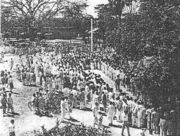
Students of the University of Dhaka and other colleges of the city organized a general strike in 11 March 1948 to protest the omission of Bengali language from official use, including coins, stamps and recruitment tests for the navy. The movement restated the demand that Bengali be declared an official language of Pakistan. Political leaders such as Shamsul Huq, Shawkat Ali, Kazi Golam Mahboob, Oli Ahad, Sheikh Mujibur Rahman, Abdul Wahed and others were arrested during the rallies. Rally leader Mohammad Toaha was hospitalised after attempting to snatch a rifle from a police officer. Student leaders, including Abdul Matin and Abdul Malek Ukil took part in the procession.[8]
In the afternoon of 11 March, a meeting was held to protest police brutality and arrests. A group of students marching towards the chief minister Khawaja Nazimuddin's house was stopped in front of the Dhaka High Court. The rally changed its direction and moved in the direction of the Secretariat building. Police attacked the procession injuring several students and leaders including A. K. Fazlul Huq.[18] Continuing strikes were observed from 12 March to 15 March. Under such circumstances, the chief minister Nazimuddin signed an accord with the student leaders agreeing to some of the terms and conditions, without complying to the demand that Bengali be made a state language.[8]
In the height of civic unrest, Governor-General of Pakistan Muhammad Ali Jinnah arrived in Dhaka on 19 March 1948. On 21 March, at a civic reception at Racecourse Ground, he claimed that the language issue was designed by a "fifth column" to divide Pakistani Muslims.[19][20][21][22][23] Jinnah further declared that "Urdu, and only Urdu" embodied the spirit of Muslim nations and would remain as the state language,[8][21][24][25] labelling those who disagreed with his views as "Enemies of Pakistan". Jinnah delivered a similar speech at Curzon Hall of the University of Dhaka on 24 March.[9] At both meetings, Jinnah was interrupted by large segments of the audience. He later called a meeting of a state language committee of action, and overruled the contract that was signed by Khawaja Nazimuddin with the student leaders.[18] Before Jinnah left Dhaka on 28 March, he delivered a speech on radio reasserting his "Urdu-only" policy.[26]
Shortly thereafter, the East Bengal Language Committee, presided by Maulana Akram Khan, was formed by the East Bengal government to prepare a report on the language problem.[27] The Committee completed its report on 6 December 1950, but it was not published until 1958. The government suggested that Bengali be written in Arabic script, as a potential solution to the language conflict.[28]
Events of 1952
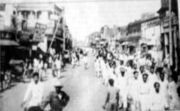
The Urdu-Bengali controversy was reignited when Jinnah's successor, governor-general Khawaja Nazimuddin, staunchly defended the "Urdu-only" policy in a speech on 27 January 1952.[18] On 31 January, the Shorbodolio Kendrio Rashtrobhasha Kormi Porishod (All-Party Central Language Action Committee) was formed in a meeting at the Bar Library Hall of the University of Dhaka, chaired by Maulana Bhashani.[8][29] The central government's proposal of writing the Bengali language in Arabic script was vehemently opposed at the meeting. The action committee called for an all out protest on 21 February, including strikes and rallies.[18] Students of the University of Dhaka and other institutions gathered on the university premises on 4 February and warned the government to withdraw its proposal to write Bengali in Arabic script, and insisted on the recognition of Bengali. As the preparation for demonstrations was going on, government imposed Section 144 in the city of Dhaka, thereby banning any gatherings of more than four people.
21 February
At nine o'clock in the morning, students began gathering on the University of Dhaka premises in defiance of Section 144. The university vice-chancellor and other officials were present as armed police surrounded the campus. By a quarter past eleven, students gathered at the university gate and attempted to break the police line. Police fired tear gas shells towards the gate to warn the students.[8] A section of students ran into the Dhaka Medical College while others rallied towards the university premises cordoned by the police. The vice-chancellor asked police to stop firing and ordered the students to leave the area. However, the police arrested several students for violating section 144 as they attempted to leave. Enraged by the arrests, the students met around the East Bengal Legislative Assembly and blocked the legislators' way, asking them to present their insistence at the assembly. When a group of students sought to storm into the building, police opened fire and killed a number of students, including Abdus Salam, Rafiq Uddin Ahmed, Abul Barkat and Abdul Jabbar.[8][30] As the news of the killings spread, disorder erupted across the city. Shops, offices and public transport were shut down and a general strike began.[24] At the assembly, six legislators including Manoranjan Dhar, Boshontokumar Das, Shamsuddin Ahmed and Dhirendranath Datta requested that chief minister Nurul Amin visit wounded students in hospital and that the assembly be adjourned as a sign of mourning.[31] This motion was supported by some of the treasury bench members including Maulana Abdur Rashid Tarkabagish, Shorfuddin Ahmed, Shamsuddin Ahmed Khondokar and Mosihuddin Ahmed.[31] However Nurul Amin refused the requests.[8][31]
22 February
Disorder spread across the province as large processions ignored section 144 and condemned the actions of the police.[18] More than 30,000 people congregated at Curzon Hall in Dhaka. During the continued protests, police actions led to the death of four more people. This prompted officers and clerks from different organizations, including colleges, banks and the radio station, to boycott offices and join the procession.[24] Protesters burned the offices of two leading pro-government news agencies, the Jubilee Press and the Morning News.[32] Police fired on a major janaza, or mourning rally, as it was passing through Nawabpur Road. The shooting killed several people including activist Sofiur Rahman and a nine-year old boy named Ohiullah.[8][33]
Continued unrest
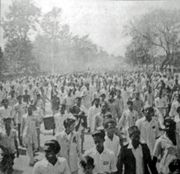
Through the night of 23 February, students of Dhaka Medical College worked on the construction of a Shaheed Smritistombho, or Monument of Martyrs. Completed at dawn on 24 February, the monument had a handwritten note attached to it with the words "Shaheed Smritistombho".[34] Inaugurated by the father of the slain activist Sofiur Rahman, the monument was destroyed on 26 February by police.[35] On 25 February, industrial workers in the town of Narayanganj observed a general strike.[36] A protest followed on 29 February whose participants faced severe police beating.[37]
The government censored news reports and withheld exact casualty figures during the protests. Most pro-government media held Hindus and communists responsible for encouraging the disorder and student unrest.[38] The families of Abul Barkat and Rafiq Uddin Ahmed tried to charge the police with murder, but the charges were dismissed by the police. An 8 April government report on the incidents failed to show any particular justification for police firings on the students.[39] When the constituent assembly reconvened on 14 April, proceedings were stalled by members of the Muslim League when legislators from East Bengal sought to raise the language issue.[40] On 16 April, the University of Dhaka reopened and the Shorbodolio Kendrio Rashtrobhasha Kormi Porishod, or All-Party Central Language Action Committee, held a seminar on 27 April at the Bar Association Hall. At the meeting delegates urged the government to release prisoners, relax restrictions on civil liberties and adopt Bengali as an official language.
Events after 1952
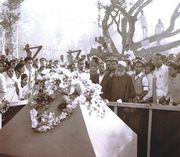
The Shorbodolio Kendrio Rashtrobhasha Kormi Porishod, with support from the Awami League, decided to commemorate 21 February as Shohid Dibosh (Martyrs' Day). On the first anniversary of the protests, people across East Pakistan wore black badges in solidarity with the victims. Most offices, banks and educational institutions were closed to observe the occasion. Student groups made agreements with college and police officials to preserve law and order. More than 100,000 people assembled at a public meeting held in Armanitola in Dhaka, where community leaders called for the immediate release of Maulana Bhashani and other political prisoners.[8] However, West Pakistani politicians such as Fazlur Rahman aggravated sectional tensions by declaring that anyone who wanted Bengali to become an official language would be considered an "enemy of the state." Bengali students and civilians disobeyed the restrictions to celebrate the anniversary of the protests. Demonstrations broke out on the night of 21 February 1954 with various halls of the University of Dhaka raising black flags in mourning.[41] Police arrested students and other protesters, who were released later despite refusing to post bail.
United Front in 1954
Political tensions came to a head as elections to the provincial assembly of East Bengal were held in 1954. The ruling Muslim League denounced the opposition United Front coalition, which—led by A. K. Fazlul Huq and the Awami League—wanted greater provincial autonomy. Several United Front leaders and activists were arrested.[42] A meeting of parliament's Muslim League members, chaired by prime minister Muhammad Ali Bogra, resolved to give official recognition to Bengali. This decision was followed by a major wave of unrest as other ethnic groups sought the recognition of other regional languages. Proponents of Urdu such as Maulvi Abdul Haq condemned any proposal to grant official status to Bengali. He led a rally of 100,000 people to protest against Muslim League's decision.[43][44] Consequently, the implementation failed and the United Front won a vast majority of seats in the legislative assembly, while the representation of the Muslim League was reduced to a historic low.[24][44]
The United Front ministry ordered the creation of the Bangla Academy to promote, develop, and preserve Bengali language, literature, and heritage.[45] However, the United Front rule was temporary, as Governor General Ghulam Muhammad cancelled the government and started ruling under governor on 30 May 1954.[42] United Front again formed the ministry on 6 June 1955 after the governor's regime ended. Awami League did not participate in this ministry though.[46]
Following the return of the United Front to power, the anniversary on 21 February 1956 was observed for the first time in a peaceful atmosphere. Government supported a major project to construct a new Shaheed Minar. The session of the constituent assembly was stopped for five minutes to express condolence for the students slain in the police shootings. Major rallies were organised by Bengali leaders and all public offices and businesses remained closed.[46][47]
Constitution reform
On 7 May 1954, the constituent assembly resolved, with the Muslim League's support, to grant official status to Bengali.[44] Bengali was recognised as the second official language of Pakistan on 29 February 1956, and article 214(1) of the constitution of Pakistan was reworded to "The state language of Pakistan shall be Urdu and Bengali."
However, the military government formed by Ayub Khan made attempts to re-establish Urdu as the sole national language. On 6 January 1959, the military regime issued an official statement and reinstated the official stance of supporting the 1956 constitution's policy of two state languages.[48]
Liberation of Bangladesh
Although the question of official languages was settled by 1956, the military regime of Ayub Khan promoted the interests of West Pakistan at the expense of East Pakistan. Despite forming the majority of the national population, the East Pakistani community continued to be under-represented in the civil and military services, and received a minority of state funding and other government help.This was mainly due to lack of representative government in the fledgling state.Mainly due to regional economic imbalances sectional divisions grew, and support for the Bengali ethnic nationalist Awami League,[21] which invoked the 6-point movement for greater provincial autonomy. One demand was that East Pakistan be called Bangladesh (Land of Bengalis), which subsequently led to the Bangladesh Liberation War.[3][9]
Legacy
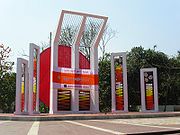
The Language Movement had a major cultural impact on Bengali society. It has inspired the development and celebration of the Bengali language, literature and culture. 21 February, celebrated as Language Movement Day or Shohid Dibosh (Martyrs' Day), is a major national holiday in Bangladesh. A month-long event called the Ekushey Book Fair is held every year to commemorate the movement. Ekushey Padak, one of the highest civilian awards in Bangladesh, is awarded annually in memory of the sacrifices of the movement.[49] Songs such as Abdul Gaffar Choudhury's Amar Bhaier Rokte Rangano, set to music by Shaheed Altaf Mahmud, as well as plays, works of art and poetry played a considerable role in rousing the people's emotions during the movement.[50] Since the events of February 1952, poems, songs, novels, plays, films, cartoons and paintings were created to capture the movement from varied point of views. Notable artistic depictions include the poems Bornomala, Amar Dukhini Bornomala and February 1969 by Shamsur Rahman, the film Jibon Theke Neya by Zahir Raihan, the stage play Kobor by Munier Chowdhury and the novels Ekushey February by Raihan and Artonaad by Shawkat Osman.[51] Bangladesh officially sent a proposal to UNESCO to declare 21 February as "International Mother Language Day." The proposal was supported unanimously at the 30th General Conference of UNESCO held on 17 November 1999.[52]
Two years after the first monument was destroyed by the police, a new Shaheed Minar (Monument of Martyrs) was constructed in 1954 to commemorate the protesters who lost their lives. Work on a larger monument designed by the architect Hamidur Rahman began in 1957 with the support of the United Front ministry. Hamidur Rahman’s model consisted of a large complex in the yard of the Dhaka Medical College Hostel. The design included a half-circular column symbolizing a mother with her martyred sons standing at the dais in the center of the monument. Although the imposition of martial law in 1958 interrupted the work, the monument was completed and inaugurated on 21 February 1963 by Abul Barkat's mother, Hasina Begum. Pakistani forces demolished the monument during the Bangladesh Liberation War of 1971, but the Bangladeshi government reconstructed it in 1973.[53]
Outside East Pakistan, movement for equal status of Bengali also took place in the Indian state of Assam. On May 19, 1961, 11 Bengalis were killed in Police firing in Silchar Railway Station, Assam, while demanding state recognition of Bengali language. Subsequently, Bengali was given semi-official status in the three Bengali-majority districts of Assam.[54]
Criticism
Although the Language Movement is considered to have laid the foundations for ethnic nationalism in many of the Bengalis of East Pakistan, it also heightened the cultural animosity between the authorities of the two wings of Pakistan.[3][21][55] In West Pakistan, the movement was seen as a sectional uprising against Pakistani national interests.[56] The rejection of the "Urdu-only" policy was seen as a contravention of the Perso-Arabic culture of Muslims and the founding ideology of Pakistan, the Two-Nation Theory.[3] Some of the most powerful West Pakistani politicians considered Urdu a product of Indian Islamic culture, while they saw Bengali as a part of "Hinduized" Bengali culture.[9]Most,however,stood by the 'Urdu only' policy as they believed that only a single language,one that was not ingdigenous to Pakistan,should serve as the national language.This kind of thinking also provoked considerable opposition in West Pakistan,wherein there existed several linguistic groups.[9] As late as in 1967,military dictator Ayub Khan said, "East Bengal is...still are under considerable Hindu culture and influence."[9]
The Awami Muslim League turned over to Bengali nationalism after the Movement, and shed the word "Muslim" from its name.[57] This ethnic nationalist approach of the party led to alienation of leaders such as Golam Azam who were supportive of the Muslim activism rather than the ethnic nationalist approach. The Language Movement inspired similar discontent in West Pakistan and provided momentum to ethnic nationalist parties .[3] The political unrest in East Pakistan and rivalry between the central government and the United Front-led provincial government was one of the main factors culminating in the 1958 military coup by Ayub Khan.[24]
Citations
- ↑ Glassie, Henry and Mahmud, Feroz.2008.Living Traditions. Cultural Survey of Bangladesh Series-II. Asiatic Society of Bangladesh. Dhaka. p.578
- ↑ 2.0 2.1 Upadhyay, R (2003-05-01). "Urdu Controversy - is dividing the nation further.". Papers. South Asia Analysis Group. http://www.southasiaanalysis.org/papers7/paper675.html. Retrieved 2008-02-20.
- ↑ 3.0 3.1 3.2 3.3 3.4 Rahman, Tariq (1997). "The Medium of Instruction Controversy in Pakistan" (PDF). Journal of Multilingual and Multicultural Development 18 (2): 145–154. doi:10.1080/01434639708666310. ISSN 0143-4632. http://www.multilingual-matters.net/jmmd/018/0145/jmmd0180145.pdf. Retrieved 2007-06-21.
- ↑ Halder, Shashwati. "Apabhrangsha". Banglapedia. Asiatic Society of Bangladesh. http://www.bpedia.org/A_0273.php. Retrieved 2007-07-08.
- ↑ "A Historical Perspective of Urdu". National Council for Promotion of Urdu language. http://www.urducouncil.nic.in/pers_pp/index.htm. Retrieved 2007-06-15.
- ↑ Bhattacharya, T (2001). "Bangla". In Gary, J. and Rubino, C. (Eds) (PDF). Encyclopedia of World's Languages: Past and Present (Facts About the World's Languages). New York: HW Wilson. ISBN 0824209702. http://www.homepages.ucl.ac.uk/~uclyara/bong_us.pdf. Retrieved 2007-06-20.
- ↑ Rahman, Tariq (February 1997). "The Urdu-English Controversy in Pakistan". Modern Asian Studies 31 (1): 177–207. doi:10.1017/S0026749X00016978. ISSN 1469-8099. http://links.jstor.org/sici?sici=0026-749X%28199702%2931%3A1%3C177%3ATUCIP%3E2.0.CO%3B2-X. Retrieved 2007-06-23.
- ↑ 8.00 8.01 8.02 8.03 8.04 8.05 8.06 8.07 8.08 8.09 8.10 8.11 8.12 8.13 8.14 "Language Movement" (PHP). Banglapedia - The National Encyclopedia of Bangladesh. Asiatic Society of Bangladesh. http://www.banglapedia.org/httpdocs/HT/L_0063.HTM. Retrieved 2007-02-06.
- ↑ 9.0 9.1 9.2 9.3 9.4 9.5 Oldenburg, Philip (August 1985). ""A Place Insufficiently Imagined": Language, Belief, and the Pakistan Crisis of 1971". The Journal of Asian Studies (The Journal of Asian Studies, Vol. 44, No. 4) 44 (4): 711–733. doi:10.2307/2056443. ISSN 0021-9118. http://links.jstor.org/sici?sici=0021-9118(198508)44%3A4%3C711%3A%22PIILB%3E2.0.CO%3B2-C. Retrieved 2007-06-21.
- ↑ Morning News. 7 December 1947
- ↑ (in Bengali)The Azad (a daily newspaper) (Abul Kalam Shamsuddin, Dhaka). 11 December 1948
- ↑ (Umar 1979, p. 35)
- ↑ (Al Helal 2003, pp. 227–28)
- ↑ The Azad. 29 July 1947
- ↑ (Umar 1979, pp. 30–32)
- ↑ (in Bengali) Ekusher Shongkolon '80. Dhaka: Bangla Academy. 1980. pp. 102–103.
- ↑ Rahman, Hasan Hafizur (1982). Bangladesher Swadhinotajuddher Dolilpotro. Ministry of Information, People's Republic of Bangladesh.
- ↑ 18.0 18.1 18.2 18.3 18.4 (Al Helal 2003, p. 263–265)
- ↑ Choudhury, G. W. (April 1972). "Bangladesh: Why It Happened". International Affairs (Royal Institute of International Affairs) 48 (2): 242–249. doi:10.2307/2613440. ISSN 0020-5850. http://jstor.org/stable/2613440.
- ↑ (Umar 1979, p. 279)
- ↑ 21.0 21.1 21.2 21.3 (Uddin 2006, pp. 3–16, 120–124)
- ↑ The Azad. 24 February 1948
- ↑ R. Upadhyay (2007-04-07). "De-Pakistanisation of Bangladesh". Bangladesh Monitor, South Asia Analysis Group. http://www.saag.org/%5Cpapers22%5Cpaper2199.html. Retrieved 2007-06-16.
- ↑ 24.0 24.1 24.2 24.3 24.4 James Heitzman and Robert Worden (eds), ed (1989). "Pakistan Period (1947–71)". Bangladesh: A Country Study. Government Printing Office, Country Studies US. ISBN 0160177200. http://countrystudies.us/bangladesh/14.htm. Retrieved 2007-06-16.
- ↑ Sayeed, Khalid Bin (September 1954). "Federalism and Pakistan". Far Eastern Survey 23 (9): 139–143. doi:10.1525/as.1954.23.9.01p0920l. ISSN 0362-8949. http://links.jstor.org/sici?sici=0362-8949(195409)23%3A9%3C139%3AFAP%3E2.0.CO%3B2-S.
- ↑ (Umar 1979, p. 290)
- ↑ Mandal, Ranita (2002-06-24). "Chapter 4 : Other Activities". Muhammad Shahidullah & His Contribution To Bengali Linguistics. Central Institute of Indian Languages, Mysore, India. http://www.ciil-ebooks.net/html/benling/chapter4.html. Retrieved 2007-06-23.
- ↑ The Azad. 24 May 1950
- ↑ The Azad. 1 February 1952
- ↑ "Dhaka Medical College Hostel Prangone Chatro Shomabesher Upor Policer Guliborshon. Bishwabidyalayer Tinjon Chatroshoho Char Bekti Nihoto O Shotero Bekti Ahoto" (in Bengali). The Azad. 22 February 1952.
- ↑ 31.0 31.1 31.2 (Al Helal 2003, pp. 377–393)
- ↑ "Banglake Pakistaner Onnotomo Rashtrabhasa Korar Jonno Purbobongo Babostha Porishoder Shoparesh. Shukrobar Shohorer Obosthar Aaro Obonoti : Shorkar Kortrik Shamorik Bahini Tolob. Police O Shenader Gulite Charjon Nihoto O Shotadhik Ahoto : Shatghontar Jonno Curfew Jari. Shohidder Smritir Proti Sroddha Gyaponarthay Shotosfurto Hartal Palan" (in Bengali). The Azad. 23 February 1952.
- ↑ (Al Helal 2003, p. 483)
- ↑ The Azad. 25 February 1952
- ↑ The Daily Star. 27 February 1952
- ↑ The Azad. 26 February 1952
- ↑ (Umar 1979, pp. 417–418)
- ↑ (Al Helal 2003, pp. 515–523)
- ↑ (Al Helal 2003, pp. 546–552)
- ↑ The Azad. 20 March 1952
- ↑ (Al Helal 2003, pp. 604–609)
- ↑ 42.0 42.1 (Al Helal 2003, pp. 600–603)
- ↑ The Azad. 22 April 1954
- ↑ 44.0 44.1 44.2 "UF elections victory" (PHP). Chronicles of Pakistan. http://therepublicofrumi.com/54.htm. Retrieved 2007-06-16.
- ↑ "Bangla Academy". Banglapedia: The National Encyclopedia of Bangladesh. Asiatic Society of Bangladesh. http://banglapedia.search.com.bd/HT/B_0134.htm. Retrieved 2007-07-05.
- ↑ 46.0 46.1 (Al Helal 2003, pp. 608–613)
- ↑ "Gambhirjopurno Poribeshay Shaheed Dibosh Utjapon" (in Bengali). Weekly Notun Khobor. 26 February 1956.
- ↑ Lambert, Richard D. (April 1959). "Factors in Bengali Regionalism in Pakistan". Far Eastern Survey 28 (4): 49–58. doi:10.1525/as.1959.28.4.01p1259x. ISSN 0362-8949.
- ↑ Khan, Sanjida. "National Awards". Banglapedia. Asiatic Society of Bangladesh. http://banglapedia.search.com.bd/HT/N_0081.htm. Retrieved 2007-06-23.
- ↑ Aminzade, Ronald; Douglas McAdam, Charles Tilly (17 September 2001). "Emotions and Contentious Politics". Silence and Voice in the Study of Contentious Politics. Cambridge: Cambridge University Press. p. 42. ISBN 0521001552. http://books.google.com/?id=h8PNEOZRRt8C&printsec=frontcover&dq=bangladesh+language+movement. Retrieved 2007-06-24.
- ↑ Islam, Rafiqul (2000) (in Bengali). Amar Ekushey O Shaheed Minar. Dhaka: Poroma. pp. 62–85. ISBN 984-8245-39-1.
- ↑ "International Mother Language Day - Background and Adoption of the Resolution". Government of Bangladesh. http://www.pmo.gov.bd/21february/imld_back.htm. Retrieved 2007-06-21.
- ↑ Imam, Jahanara (1986) (in Bengali). Ekattorer Dingulee. Dhaka: Shondhani Prokashani. p. 44. ISBN 984-480-000-5.
- ↑ Court route for language status , The Telegraph, May 20, 2008.
- ↑ "Bangladesh History". Discovery Bangladesh. http://www.discoverybangladesh.com/history.html. Retrieved 2007-06-21.
- ↑ Rahman, Tariq (September 1997). "Language and Ethnicity in Pakistan". Asian Survey 37 (9): 833–839. doi:10.1525/as.1997.37.9.01p02786. ISSN 0004-4687. http://links.jstor.org/sici?sici=0004-4687(199709)37%3A9%3C833%3ALAEIP%3E2.0.CO%3B2-R. Retrieved 2007-06-21.
- ↑ Lintner, Bertil (January 2004). "Chapter 17: Religious Extremism and Nationalism in Bangladesh". In eds Satu Limaye, Robert Wirsing, Mohan Malik (PDF). Religious Radicalism and Security in South Asia. Honolulu, Hawaii: Asia-Pacific Center for Security Studies. p. 413. ISBN 0971941661. http://www.apcss.org/Publications/Edited%20Volumes/ReligiousRadicalism/PagesfromReligiousRadicalismandSecurityinSouthAsiach17.pdf. Retrieved 2007-06-28.
References
- Al Helal, B (2003). Bhasha Andoloner Itihas (History of the Language Movement). Agamee Prakashani, Dhaka. ISBN 984-401-523-5 (Bengali)
- Uddin, Sufia M. (2006). Constructing Bangladesh: Religion, Ethnicity, and Language in an Islamic Nation. Chapel Hill: The University of North Carolina Press. ISBN 0807830216
- Umar, B (1979). Purbo-Banglar Bhasha Andolon O Totkalin Rajniti. Agamee Prakashani, Dhaka (Bengali)
Further reading
- Badruddin Umar (2004). The Emergence of Bangladesh: Class Struggles in East Pakistan (1947-1958). Oxford University Press, USA. ISBN 978-0195795714.
- Anwar S. Dil (2000). Bengali language movement to Bangladesh. Ferozsons. ISBN 978-9690015778.
- Robert S. Stern (2000). Democracy and Dictatorship in South Asia: Dominant Classes and Political Outcomes in India, Pakistan, and Bangladesh. Praeger Publishers. ISBN 978-0275970413.
- Syed Manzoorul Islam (1994). Essays on Ekushey: The Language Movement 1952. Bangla Academy. ISBN 984-07-2968-3.
External links
- Bangla language movement
- The Makers of History: International Mother Language Day
- Language movement at BSS
- History of Bangladesh
- Language movement at Virtual Bangladesh
- Language movement at Banglapedia
|
|||||||||||
|
||||||||||||||